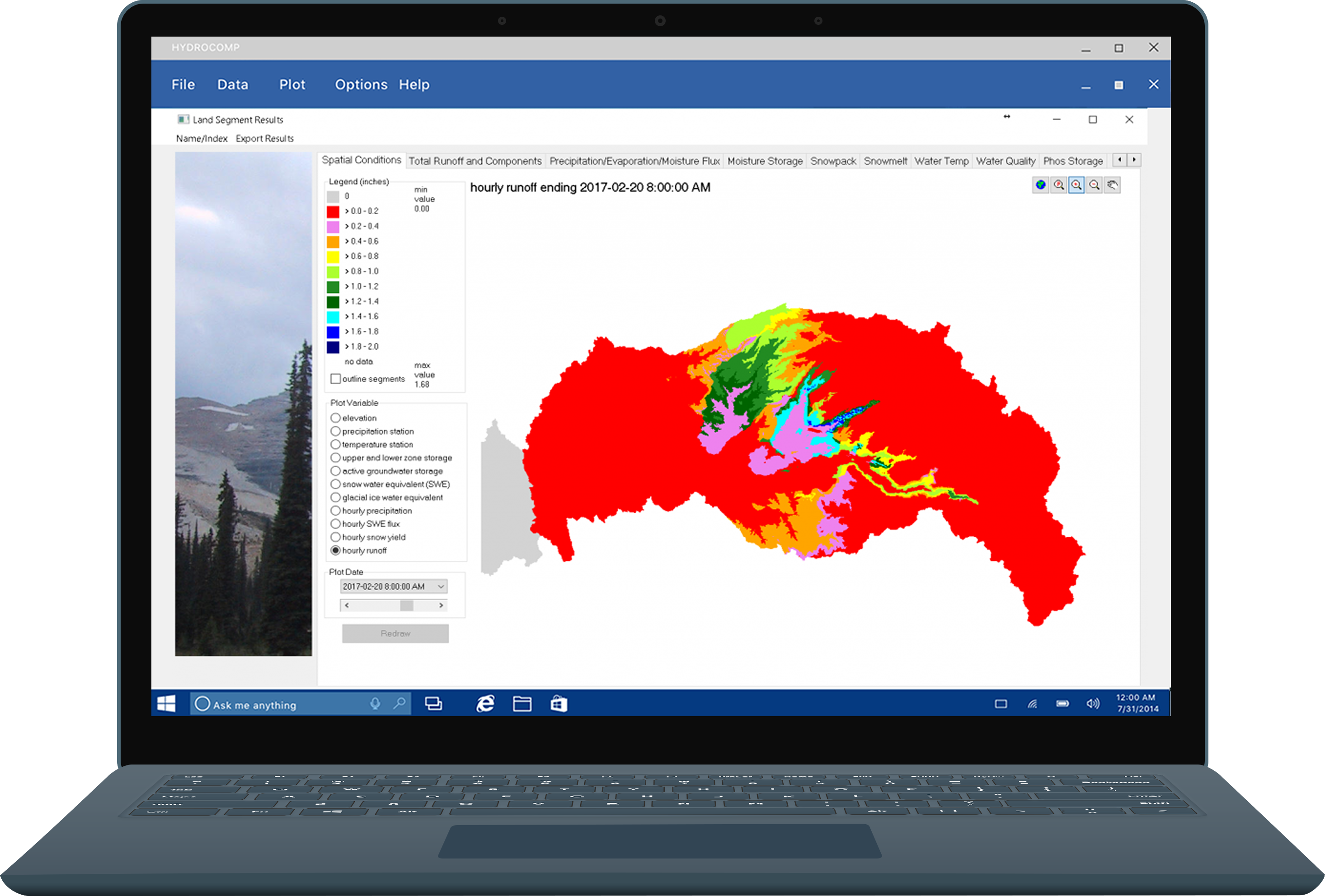Calibration Methods for Streamflow
Tuolumne River, CA
Project: Turlock Irrigation District
HFAM calibration methods to discover water balance

Most calibration methods for streamflow apply to HSPF (Hydrologic Simulation Program-Fortran) parameter calibration as well since HFAM and HSPF share many algorithms and parameters.
HFAM uses an input meteorological time series of precipitation and potential evapotranspiration. For snowmelt, time series for air temperature, solar radiation, dew point and wind velocity are added (see Calibration Methods for Snowmelt).
Schedule Your HFAM Demo.
Fundamental hydrologic processes

INFILTRATION
The movement of water during rainfall into the soil. A portion of this water becomes interflow and base (or groundwater) flow in streams. Actual evapotranspiration occurs from water that has infiltrated and is held in the soil

ACTUAL EVAPOTRANSPIRATION
The combination of evaporation from soils and transpiration from vegetation. By definition, actual evapotranspiration is less than, or equal to, the current potential evapotranspiration where potential evapotranspiration is the rate at which water would evaporate from a free water surface (e.g.: lake). Actual evapotranspiration varies with soil properties, soil moisture, and vegetation.

SOIL MOISTURE
The storage or capture of water in soils for later evaporation, transpiration, or movement into perched or deep groundwater aquifers. Soil moisture variations control infiltration rate variations at the watershed surface.

SURFACE RUNOFF, INTERFLOW, GROUNDWATER FLOW
HFAM models three paths for water movement from the land surface into streams. HFAM models surface runoff as a flow on an inclined plane, where the slope, length, and roughness of the plane are model parameters. Surface runoff occurs when rainfall rates exceed infiltration rates at the surface of a land segment.
Accounting For Interfow and Groundwater Flow Are Vital For Calibration
Interflow is water that infiltrates as flows in the soil along preferred pathways. Preferred pathways originate as animal and insect burrows, shrinkage cracks, roots of plants, and as buried microscale flow paths where flowing water has deposited relatively coarse or permeable sediments. Tillage of agricultural lands may also create preferred pathways.
Data typically available for calibration:
- Precipitation – Class-A pan evaporation, and streamflow records
- Lake levels or contents
- Groundwater levels
- Records of changing land use such as urbanization, forestry, and agricultural land use
- Records of changes in the channel system, storm drain construction, construction of detention basins, and reservoirs
Interflow pathways are not necessarily continuous. Water may flow subsurface for a short distance, and then return to the surface and become surface runoff. Water moving on interflow pathways may also infiltrate into surrounding soils.
Groundwater flow is subsurface, saturated zone flow that contributes to stream channels. Groundwater flow creates the base flow in streams weeks (or months) after the precipitation or snowmelt has occurred in a watershed.
If the saturated zone in a watershed is below the stream channels and the channels are influent rather than effluent, deep percolation is occurring, and a model parameter represents the amount of water on this flow path.
Modeling three hydrologic flow paths is fictional. The actual number of flow paths that will exist in a watershed is unlimited. The three flow paths are a convenience for modeling that allows a small number of parameters to represent continuously varying processes.
HFAM model parameters control how the hydrologic processes operate. The effect or importance of any given parameter or process will vary from one watershed to another.
Learn more about how snowmelt and accumulation impacts a watershed.
Selecting HFAM Land Surface Segments
HFAM uses lands surface segments that are homogeneous. The land surface segments experience the same time series of precipitation and potential evapotranspiration. They also carry the same mean soil properties, vegetation, and topography.
HFAM uses lands surface segments that are homogeneous. The land surface segments experience the same time series of precipitation and potential evapotranspiration. They also carry the same mean soil properties, vegetation, and topography.
Algorithms cause important soil properties like infiltration capacity to vary within a land segment. HFAM does not limit the number of land surface segments you may use. Segments need not be contiguous.
With HFAM, you may base the land surface segment boundaries on GIS overlays of precipitation, soils, vegetation, and topography. However, the selection of criteria for creating segments is subjective.
HFAM includes the similarity of elevation, temperatures, and aspect in watersheds that include snow accumulation and melt in addition to the factors above.
Calibration of Hydrologic Land/Soil Parameters
HFAM lists each parameter under the hydrologic process that it primarily affects. There is interaction among parameters, in particular for parameters affecting streamflow volumes. This interaction occurs in nature and modeling.
Principal HFAM parameters for hydrologic processes
 Watershed Water Balance
Watershed Water Balance
With HFAM, you may view the soil profile as water holding capacity limited, or as infiltration capacity limited. The soil profile may become saturated so that it will hold no additional water, or it might have such low permeability that very little water may enter, even though water holding capacity is present.
Soil profiles usually become water holding capacity limited more often than they become infiltration capacity limited.
Other parameters in HFAM that may affect watershed water balance, in addition to the parameters listed above under Streamflow Volumes, are FOREST, PETMAX, PETMIN, and DEEPFR.
Water balance is relatively insensitive to FOREST, PETMAX and PETMIN. However, non-zero values of DEEPFR have a significant effect on water balance.
PETMAX
Definition: Manning’s n coefficient for the overland flow plane.
Hydrologic process: Overland flow
PETMIN
Definition: The air temperature below which evapotranspiration will be reduced to zero, instead of the value in the input time series
Hydrologic Process: Evapotranspiration
DEEPFR
Definition: Fraction of ground water inflow which will enter deep (inactive) groundwater. This water will be lost from the system unless the land segment is linked to an aquifer element
Hydrologic Process: Active Groundwater Flow
LZSN
Definition: Lower zone nominal storage.
Hydrologic Process: Soil Moisture Storage, Infiltration
UZSN
Definition: Upper zone nominal storage.
Hydrologic Process: Soil Moisture Storage
INFILT
Definition: Index to the infiltration capacity of the soil
Hydrologic Process: Infiltration
BAGW
Definition: Hyperbolic interflow and groundwater recession
Hydrologic Process: Active Groundwater Flow
 Soil Moisture, Actual Evapotranspiration
Soil Moisture, Actual Evapotranspiration
While soil moisture storage is critical, traditional hydrologic analysis poorly approximates soil moisture storage. Soil moisture storage controls the division between subsurface and surface flows and affects runoff timing (floods) and water balance.
Both heterogeneity (areal variability) and variability in time with infiltration and soil moisture storage are crucial.
There is the interaction of soil moisture storage parameters, LZSN and UZSN, and the infiltration rate parameter INFILT. Simulating the time invariant by adding hyperbolic recession outflows through the BAGW parameter resolves the interaction soil moisture storage and evapotranspiration since INFILT also affects seasonal and low flows.
 Seasonal and Low Flows
Seasonal and Low Flows
Seasonal and low flows are relatively simple to model since these processes are well damped in most watersheds. The AGWRC models a time invariant groundwater recession.
In watersheds where there are unusually large amounts of data on soils and soil depths, it may be possible to estimate the total volume of water in the saturated zone that contributes to streamflows.
AGWRC
Definition: Basic ground water recession rate. If there is no inflow to groundwater,
AGWRC is the ratio: (rate of flow today/rate of flow yesterday)
Hydrologic Process: Soil Moisture Storage, Active Groundwater Flow
LSUR
Definition: Length of the overland flow plane
Hydrologic process: overland flow
SLSUR
Definition: Slope of the overland flow plane
Hydrologic process: overland flow
NSUR
Definition: Manning’s n coefficient for the overland flow plane
Hydrologic process: overland flow
 Hydrograph Shape, Peak Flows
Hydrograph Shape, Peak Flows
Hydrograph shape is affected by the relative magnitudes of surface runoff and interflow. The variability occurs among watersheds and plays a role in creating unique watershed hydrologic regimes. The variability also occurs within a watershed and alters hydrograph shapes from storm to storm. Variable relative magnitudes of surface runoff and interflow also occur within a watershed and alter hydrograph shapes from storm to storm.
Channel cross-sections and slope are also important in hydrograph shape, and peak flows on all but the smallest watersheds.
On watersheds where channel flow timing is 10 minutes or less, the overland flow parameters, LSUR, SLSUR, and NSUR are critical for hydrograph shape and peak flows.
Summary of the Calibration Procedure
1. Correctly reproduce the long-term water balance in the watershed
Ignoring runoff timing in this first calibration step is important.
Difficulties with other terms present in the water balance equation will be apparent. For example, if watershed precipitation rates are over or under estimated, it may not be possible to reproduce the recorded watershed runoff.
When the long-term water balance, both simulated and observed, closely matches within reason this step is complete.
The water balance equation: Precipitation + Actual ET Storage Change = Runoff
The water balance equation applies to any time interval. When you operate HFAM using several years of meteorologic data (i.e. 3 to 10 years of data), the cumulative terms in the water balance equation (precipitation, actual evapotranspiration, and runoff) all increase. However, the storage change does not increase, and it must become small relative to the other terms.
Storage change is the difference in total storage in the watershed over the time interval.
If the watershed precipitation and runoff are accurately established, and if the long-term simulated runoff exceeds the recorded runoff, then the simulated Actual ET must be less than the watershed’s Actual ET.
To increase the simulated Actual ET, more water must be retained in the soil profile for later evapotranspiration, provided that the simulated Actual ET is less than the Potential ET. Actual ET is increased by increasing LZSN, and possibly UZSN and INFILT.
2. Calibrate seasonal and low flows
HFAM calibrates seasonal and low flows by increasing or decreasing the volume of water flowing on the groundwater flow path, or by changing the recession rate for flows on the groundwater flow path.
The volume of water moving on the groundwater flow path is sensitive to infiltration rates (INFILT). Increasing INFILT increases groundwater flows.
You may also calibrate the timing of groundwater flows. You will find observed groundwater recession rates from streamflow records.
BASETP
Definition: Fraction of the remaining P.E.T. which can be satisfied from base flow
(groundwater outflow) if enough is available
AGWETP
Definition: Fraction of the remaining P.E.T. which can be satisfied from active groundwater storage if enough is available
Hydrologic Process: Evapotranspiration
AGWRC is equal to (groundwater flow today/groundwater flow n days ago)1/n
HFAM uses the AGWETP parameter (which creates ET losses from groundwater storage), and the BASETP parameter (which creates ET losses from the outflow from groundwater storage) to refine simulated low and seasonal flows. These parameters are used together with field surveys of floodplain and streambank vegetation.
When the seasonal flows and low flows, both simulated and observed, closely match within reason this step is complete.
HFAM has now established the volume of water moving in the watershed on subsurface flow paths.
3. Calibrate hydrograph shape and peak streamflows
In Step 1, HFAM matched the total runoff both simulated and observed. In Step 2, HFAM calibrated the groundwater flows both simulated and observed. Thus, the total simulated surface runoff plus simulated interflow volume must match the observed.
HFAM provides one parameter, INTFW, to divide water between the surface runoff flow path and the interflow flow path. Increasing INTFW increases interflow and decreases surface runoff. Decreasing INTFW decreases interflow and increases surface runoff. This tradeoff does not affect water balance or seasonal and low flows.
INTFW
Definition: Interflow inflow parameter
Hydrologic Process: Infiltration, interflow


 Hydrograph Shape, Peak Flows
Hydrograph Shape, Peak Flows